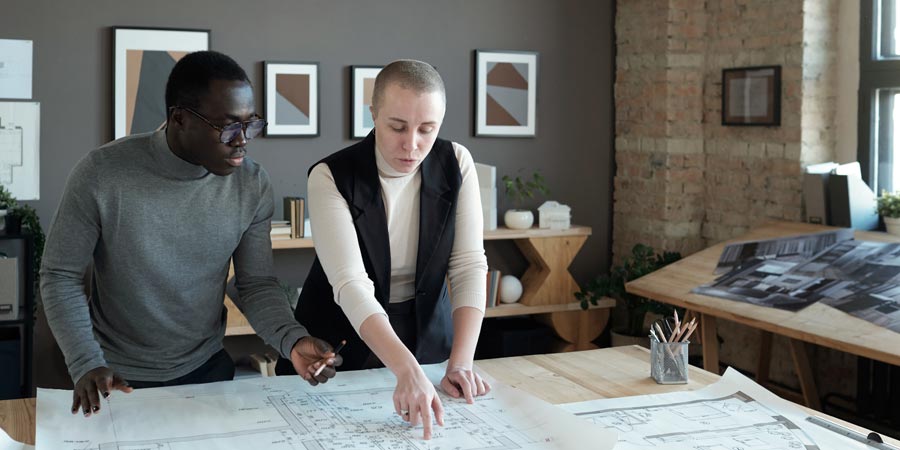
Walking through the construction site of Denver International Airport’s recent terminal expansion, you will notice something telling: nearly every exterior trim piece was synthetic. Not because it was cheaper—it wasn’t—but because the project’s LEED Platinum certification demanded materials with verifiable environmental credentials and 50-year performance guarantees.
This scene reflects a broader shift across the AEC industry. Sustainability has evolved from a nice-to-have checkbox into a fundamental design constraint. The numbers tell the story: construction materials account for approximately 11% of global CO2 emissions, with traditional building materials contributing around 107 kg CO2e per square meter in residential construction, according to recent research published in Frontiers.
Now, imagine replacing conventional materials with synthetic alternatives, such as composite decking, PVC trim systems, and recycled plastic lumber. These aren’t your grandfather’s vinyl siding options. Today’s engineered synthetics are prompting us to reevaluate what “sustainable” truly means. When a composite deck lasts 30 years versus pressure-treated wood’s 10-15 year lifespan, which choice truly minimizes environmental impact?
Chinmay Jha, a materials expert at Uppteam, puts it bluntly: “We’re not choosing between good and bad anymore. We’re optimizing between different types of trade-offs.”
Deconstructing Synthetic Materials: Performance Data That Matters
The synthetic materials landscape has fragmented into highly specialized products, each targeting specific performance gaps. Here’s what the data reveals:
Composite Decking: The Success Story of Recycling
Contemporary composite decking, such as Trex, consists of 95% recycled materials—primarily repurposed polyethylene and recycled wood fibers sourced from shopping bags and food packaging. The material science is impressive: wood fiber provides structural integrity while plastic creates weather resistance.
However, here’s the kicker—researchers at the American Chemical Society have recently developed a carbon-negative composite decking that stores more CO2 during its lifecycle than is required for manufacturing. Early prototypes sequester approximately 1.8 kg of CO2 per square foot over a 25-year lifespan.
Performance Numbers:
- Service life: 25-30 years (vs. 10-15 for pressure-treated wood)
- Maintenance cycles: Every 5-7 years, cleaning (vs. annual staining/sealing for timber)
- Thermal expansion: 0.06 inches per 10 feet at 100°F differential
- Load capacity: 50 PSF residential, 100 PSF commercial applications
PVC Trim: Engineered for Precision
Cellular PVC trim boards address a specific issue: the vulnerability of traditional wood trim to moisture infiltration around windows and doors. The material’s closed-cell structure eliminates water absorption, a critical factor in building envelope performance.
James Morrison, a specifications writer at Perkins+Will, explains: “We’ve documented moisture-related callbacks drop by 78% on projects where we specify cellular PVC for trim applications. That’s not just durability—it’s risk management.”
Key Specifications:
- Water absorption: <0.1% (vs. 8-12% for wood)
- Coefficient of thermal expansion: 3.4 x 10⁻⁵ in/in/°F
- Density: 0.55 g/cm³ (lighter than most wood species)
- UV resistance: 20+ year warranty against yellowing/chalking
Recycled Plastic Lumber: The Industrial Workhorse
High-density polyethylene (HDPE) lumber is designed for applications where wood typically fails, such as marine environments, playground equipment, and industrial installations. The material’s chemical inertness makes it ideal for corrosive environments.
A case study from the Port of Long Beach’s recent pier reconstruction illustrates the economics: HDPE lumber costs 40% more upfront than treated wood but eliminates the need for replacement over the project’s 30-year design life, resulting in 60% lower total cost of ownership.
Real-World Implementation: How Leading Firms Navigate the Choices
Case Study: Skanska’s Mass Timber Integration
Skanska USA recently completed the 18-story Ascent tower in Milwaukee—the world’s tallest mass timber residential building. While the structure uses CLT (cross-laminated timber), the building envelope relies heavily on synthetic components.
“We used composite cladding systems for 65% of the exterior,” explains project architect Tim Gokhman. “The decision came down to fire performance and maintenance. Wood cladding would require treatments that conflict with our sustainability goals.”
The project’s material breakdown:
- Composite fiber cement cladding: 12,000 square feet
- Cellular PVC trim systems: 8,500 linear feet
- Traditional wood accents: 2,800 square feet (selected areas only)
A lifecycle assessment showed that the hybrid approach reduced embodied carbon by 23% compared to all-wood cladding, while meeting fire safety requirements.
Regulatory Reality: California’s Title 24 Impact
California’s Title 24 energy code updates have created unexpected consequences for material selection. The 2022 revisions emphasize whole-building performance, not just individual component efficiency.
Michael Rodriguez, principal at Gensler’s Los Angeles office, describes the shift: “We’re seeing clients choose synthetic materials specifically because they can model their long-term performance with confidence. Wood’s variability makes energy modeling complicated.”
The numbers support this trend: projects using predominantly synthetic exterior materials showed 12% better correlation between predicted and actual energy performance in post-occupancy evaluations.
Economic Analysis: Beyond First Cost
Total Cost of Ownership Models
Recent analysis from Dodge Construction Network reveals the accurate cost picture. Their 2024 report tracked 150 commercial projects over 10 years:
Synthetic Materials Average:
- Initial cost premium: 15-25%
- Maintenance costs: 40% lower annually
- Expected service life: 25-30 years
- Total cost over 20 years: 12% lower than wood alternatives
Critical Break-Even Points:
- Composite decking: 8.2 years
- PVC trim systems: 6.7 years
- Synthetic siding: 11.4 years
Labor Efficiency Factors
Synthetic materials often provide unexpected labor savings. The plastic decking market is projected to grow from $5.66 billion in 2024 to $12.30 billion by 2032, with a 10.18% compound annual growth rate (CAGR), driven partly by increased installation efficiency.
Contractors report 25-30% faster installation times for synthetic materials due to:
- Consistent dimensions (no warping/twisting)
- Pre-finished surfaces (no field painting required)
- Lightweight handling (easier transportation and positioning)
Environmental Impact: The Nuanced Reality
Lifecycle Assessment Data Points
The conversation about carbon footprint is more complex than often portrayed. Recent LCA studies from the University of Washington reveal:
Production Phase:
- Composite decking: 2.4 kg CO2e per sq ft
- Pressure-treated lumber: 1.8 kg CO2e per sq ft
- PVC trim: 3.1 kg CO2e per linear foot
- Cedar trim: 2.2 kg CO2e per linear foot
Use Phase (25-year analysis):
- Composite maintenance: 0.3 kg CO2e per sq ft
- Wood maintenance: 1.7 kg CO2e per sq ft (stains, sealers, replacement boards)
End-of-Life:
- Composites: Limited recyclability, but increasing programs
- Wood: Biodegradable, but often landfilled after treatment
The crossover point where synthetics become environmentally favorable occurs around years 7-9 for most applications.
Emerging Bio-Based Innovations
The next generation of synthetic materials is addressing concerns about recyclability. Companies like NewTechWood are developing composite systems that use agricultural waste, such as rice hulls and wheat straw, as filler materials.
These bio-composites offer:
- 35% lower embodied carbon than traditional composites
- Improved biodegradability at end-of-life
- Comparable performance to petroleum-based alternatives
Technology Integration: Digital Tools Driving Better Decisions
BIM and Material Optimization
Building Information Modeling has revolutionized how teams evaluate material trade-offs. Autodesk’s recent AEC Collection updates include integrated LCA tools that calculate environmental impact in real-time as designers modify materials.
“We can now run ‘what-if’ scenarios instantly,” says Jennifer Park, BIM manager at HOK. “Change the cladding material, and immediately see the impact on embodied carbon, cost, and maintenance schedules.”
Predictive Maintenance Models
IoT sensors embedded in synthetic materials are providing unprecedented performance data. A pilot program at UC San Diego’s campus monitored composite decking performance over three years, measuring:
- Thermal expansion patterns
- UV degradation rates
- Moisture infiltration points
- Structural load response
This data is feeding machine learning algorithms that predict maintenance needs with 89% accuracy, enabling proactive rather than reactive building management.
Future Trajectories: Prefabrication and Modular Innovation
Off-Site Construction Advantages
The AEC industry’s focus on digitalization, AI, and sustainability is driving innovation in prefabrication. Synthetic materials align perfectly with off-site construction requirements:
Dimensional Stability: Factory-controlled environments demand materials that won’t warp, shrink, or expand unpredictably. Synthetics’ engineered consistency enables tight tolerances impossible with natural materials.
Transportation Efficiency: A recent Factory OS project in California reduced shipping costs by 30% by switching from wood to synthetic cladding systems, primarily due to weight savings and stackability.
Quality Control: The predictable properties of synthetic materials enable automated quality assurance systems to detect defects before installation.
Emerging Material Categories
Research labs are developing breakthrough synthetic materials:
Carbon Fiber Composites: University of Michigan researchers created wood-fiber/carbon-fiber hybrid materials with 300% higher strength-to-weight ratios than traditional wood.
Smart Synthetics: Materials embedded with phase-change materials that regulate building temperature, reducing HVAC loads by up to 15%.
Self-Healing Polymers: Early-stage materials that can repair minor damage autonomously, potentially extending service life to 50+ years.
The Path Forward: Strategic Implementation
Decision Framework for AEC Firms
Leading firms are developing systematic approaches to material selection:
- Performance Requirements Matrix: Define non-negotiable performance criteria first
- LCA Integration: Mandate lifecycle assessments for all major material decisions
- Total Cost Modeling: Evaluate 20-year costs, not just first cost
- Client Education: Proactively present sustainability trade-offs with visual data
- Supply Chain Verification: Audit recycled content claims and manufacturing processes
Regional Considerations
Material choices vary significantly by climate zone:
Hot, Humid Climates (Southeast US): Synthetic materials offer clear advantages due to their resistance to moisture and insects.
Cold Climates (Mountain West): Thermal expansion becomes a critical factor; some synthetics require exceptional detailing.
Seismic Zones (West Coast): Lightweight synthetics reduce seismic loads but require careful connection design.
Conclusion: Uppteam’s Role in the Sustainable Materials Revolution
The synthetic materials landscape isn’t just changing—it’s fragmenting into dozens of specialized solutions, each with unique performance profiles, sustainability metrics, and implementation requirements. This complexity creates both opportunities and challenges for AEC firms trying to make informed decisions.
Success in this environment requires more than technical knowledge; it demands sophisticated design support that can synthesize performance data, visualize options, and communicate trade-offs effectively to clients and project teams.
This is precisely where Uppteam’s capabilities become transformative for forward-thinking AEC firms.
Advanced Material Visualization: Our team doesn’t just create pretty renderings—we develop photorealistic visualizations that accurately represent how synthetic materials will weather, age, and perform over time. When a client questions whether composite decking will “look fake,” our visualizations show precisely how it will appear after 5, 10, and 15 years of weathering.
Data-Driven Documentation: Our goal is to create comprehensive material comparison matrices that extend beyond basic specification sheets. Our documentation includes lifecycle cost analyses, carbon footprint comparisons, and maintenance scheduling—all formatted for easy client presentation and contractor reference.
BIM-Integrated Sustainability Analysis: Our design team integrates directly with your BIM workflows, enabling real-time sustainability analysis as design decisions evolve. We can model the environmental impact of switching from wood to composite cladding systems while maintaining design intent and budget targets.
Prefab and Modular Expertise: As the industry shifts toward off-site construction, Uppteam’s global design team brings specialized knowledge in synthetic materials optimization for prefabricated and modular systems. We understand the unique requirements of factory-built construction and can design synthetic material systems that maximize efficiency and quality control.
Global Supply Chain Intelligence: Our international team provides insights into emerging synthetic materials and manufacturing innovations before they reach mainstream US markets. This early intelligence enables our clients to specify next-generation materials that offer a competitive advantage.
Technical Problem-Solving: When synthetic materials present unique detailing challenges, such as thermal expansion joints, connection systems, and fire-stopping requirements, our engineering team develops elegant solutions that balance both performance and aesthetics.
The synthetic materials revolution isn’t slowing down; it’s accelerating. Firms that master the plastic decking market now will lead the industry, with a high chance of reaching $12.30 billion by 2032.
Uppteam doesn’t just support this transition—we accelerate it. Our global team of designers, architects, and engineers understands that sustainable design isn’t about choosing between performance and principles. It’s about optimizing both through intelligent material selection, sophisticated analysis, and compelling visualization.
The future of sustainable construction is being built today, with synthetic materials as a cornerstone technology. Partner with Uppteam to ensure your firm isn’t just keeping pace with this evolution—you’re leading it.

















